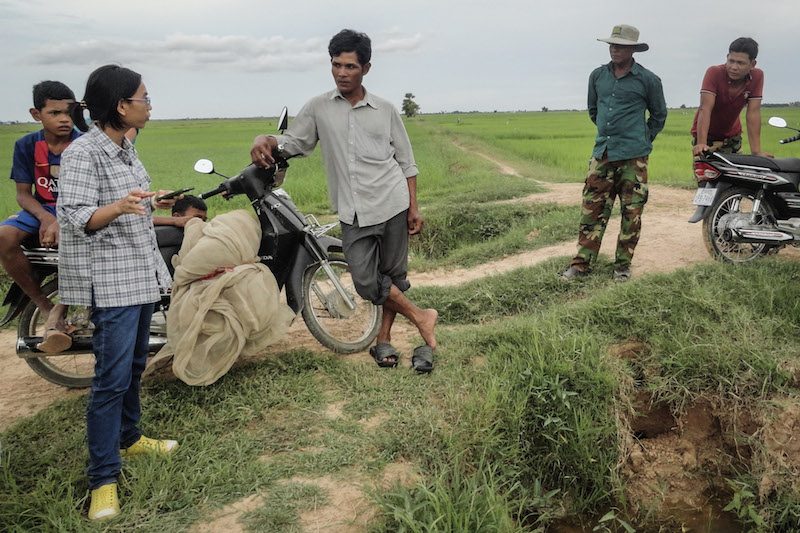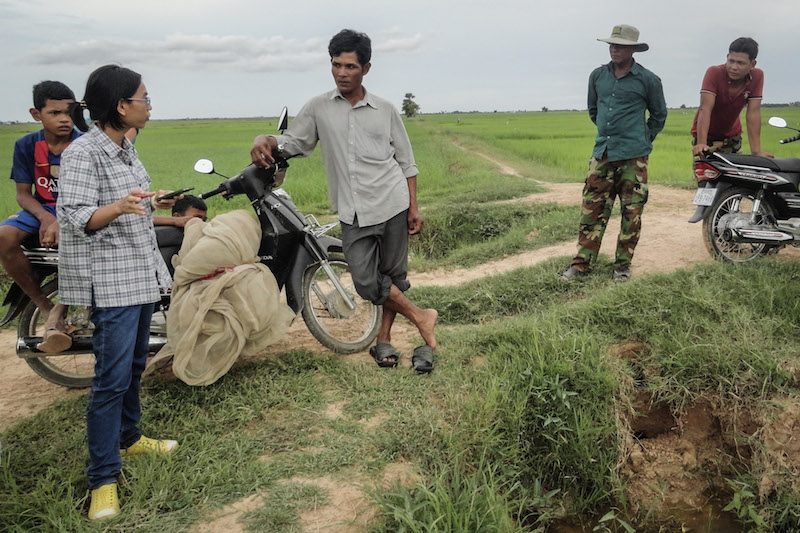Four tech innovators spent a Friday evening last month sitting in the dark with some local farmers at the edge of a rice field in Takeo province. They were trying to scare rats.
One held a small portable speaker out in front of her, directing the sound of an angry cat toward the field, while two farmers about 10 meters to their left tried to determine whether any rats were scurrying away from the amplified feline screeches.

The team was conducting a preliminary field test, assessing the theory at the heart of their business plan: that a machine emitting a sound that frightens rats out of farmers’ fields and into traps could defend crops from rodent infestation.
After winning a Southeast Asia regional product design competition in Singapore earlier this month—having qualified by winning the first round in Phnom Penh in August—the group behind “Rat Hunter” is aiming to turn their prototype into a product.
On Saturday, they started attending a boot camp for budding entrepreneurs in Phnom Penh. It was the first session of a startup incubator program in which they’ll receive business mentoring, access to technical consultants and a workspace—if they’re selected as one of the final five of an initial 10 groups chosen to participate, said Laura Smitheman, a co-founder of Impact Hub, which sponsors the USAID-funded program.
The Rat Hunter proposal’s possible “multiplier effect” and “potential to grow out of Cambodia and beyond” were among the reasons the group was chosen for the incubator, Ms. Smitheman said.
Team member Leang Chanthy said their goals went far beyond simply scaring off rats.
“If a crop is saved from the rat damage, a debt will no longer be necessary for farmers, [labor] migration will no longer be necessary and their children’s education will be possible,” she said in an email.
In Singapore, the team beat out groups from nine other cities in the region and was awarded about $720, plus invaluable exposure to investors who attended the competition, said Ki Chong Tran, one of the team’s mentors, in an email.
“There were some major investors and entrepreneurs present and they were keen on helping Rat Hunter move forward,” said Mr. Tran, the founder of ARC
Hub Phnom Penh, a 3D printing business.
Since they met at the first-round contest in August, Ms. Chanthy, Meas Likun, Pidor Lydet and Phauk Pauvrachana have been fine-tuning their prototype, which was initially a cardboard model.
While Ms. Chanthy, who works for the Cambodian Agricultural Value Chain program, has expertise in agricultural development, Ms. Pauvrachana, an English tutor, has a bachelor’s degree in enterprise management. Ms. Likun is a university student, while Mr. Lydet is a recent university graduate working for Development Innovations, which helps organizations and companies use technology to address development challenges.
They showed a deconstructed iteration of the device at the regional competition. Neon green and black versions of the 3D-printed plastic casing were displayed alongside a small amplifier and circuit board, which will be housed inside the case, Mr. Tran said.
The aspiring entrepreneurs had planned for their prototype to play the sound of a snake, a natural predator of the pesky rodents that chew up and damage crops. But after testing recordings of snakes, cats, firecrackers and vacuum cleaners on rats in cages in Phnom Penh—using a speaker connected to a mobile phone—the team found that a snake’s hiss didn’t seem to frighten them.
So they decided to retune the Rat Hunter to play the sound of an “aggressive cat” and brand the item with the menacing face of a feline, Ms. Likun said.
The team has surveyed nine rice farmers—their target consumer—to learn which rodent abatement methods are most commonly used (pesticides, fencing and electric wires) and whether farmers were satisfied with their current method. Most said the usual strategies were too costly, occasionally ineffective and sometimes dangerous.
“Talking with them, we get a lot of ideas,” Ms. Likun said, adding that it was a farmer who had suggested using a cat recording.
When asked if they would buy a $30 product that maneuvered rats into traps, seven of the nine farmers said they likely would—as long as it worked.
While the prototype will need to go through more iterations and testing before it’s fully functional, the plan is to create “a complete system” for catching rats—live, so they can also be sold as food for extra income, Mr. Tran said.
“So it is not just the sound, but also there is fencing [around the field] and [a] large trap system to scare the rats in one direction and trap them in large numbers,” he explained. Some farmers would likely be able to use their existing fencing and traps with the sound box, Ms. Pauvrachana said.
Her collaborator Ms. Chanthy acknowledged that they still have a lot to do, from developing a sustainable business model to finding sound recordings that work, but she remains optimistic.
“I am looking forward to becoming a real female entrepreneur,” she said, “to set an example that will encourage more women to start innovating, making things and starting up a business.”




